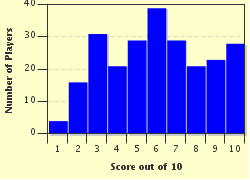Quiz Answer Key and Fun Facts
1. These siblings--three sisters and a brother--wrote fantasy stories about their brother's toy soldiers when they were children, but as adults they were well known for their poetry. Today, the three sisters' novels--"The Tenant of Wildfell Hall", "Jane Eyre", and "Wuthering Heights", for example--are celebrated as some of the best of England's nineteenth-century. What is the surname of these siblings whose father was a strict Irish Anglican minister who wrote poems himself?
2. Henry, Sr., wrote "Moralism and Christianity" and "Shadow and Substance". Wiliiam wrote "The Principles of Psychology" and "Pragmatism: A New Name for Some Old Ways of Thinking". Henry, Jr., wrote "The Golden Bowl" and "The Ambassadors". Alice wrote a famous diary. What is the surname of this famous family of scribblers?
3. The father was an Italian nationalist who wrote patriotic poetry before becoming a Professor of Italian at King's College London while living in exile. His son was a poet of the Victorian era as well as an important artist who cofounded the Pre-Raphaelite Brotherhood. His daughter, who broke off two engagements and quit playing chess for religious reasons, was also a significant Victorian poet who wrote such poems as "Goblin Market" and "An Apple Gathering". What is this creative family's surname?
4. This American Fireside Poet from the 1800s wrote such poems as "The First Snowfall", "She Came and Went", and "Ausplex"; he was also the first editor of the "Atlantic Monthly" and a U.S. ambassador to Spain. A distant cousin of his, born in 1874, became an ardent supporter of the imagist movement in Modern poetry, though she never really wrote pure imagist poetry herself, and many of her poems are celebrated in the early 21st century for their latent exploration of lesbian relationships. Another distant cousin, born in 1914, was jailed as a conscientious objector in WWII and tremendously influenced American poetry with the 1959 publication of his collection "Life Studies", and earned great popular and criticial success as he was a Poet Laureate of the United States and a winner of a Pulitzer Prize. What important American family is this, a family that has given its name to a town and a textile mill in Massachussetts?
5. Her father was a political philsopher and novelist who advocated utilitarianism and anarchism and who wrote "Enquiry Concerning Political Justice" and "The Adventures of Caleb Williams", perhaps the first mystery novel or thriller. Her mother was also a philosopher and novelist, famous for her advocacy of women's rights in works like "Vindication of the Rights of Woman" and "Mary: A Fiction". Who is the daughter of these two writers, a woman who wrote novels, short stories, travelogues, and biographies and who eloped with one of England's great Romantic poets?
6. In "Lines", this poet addresses his "dear, dear Sister", who accompanied him in 1798 on a visit of Tintern Abbey, which led to the composition of the poem. She was a writer herself, her most famous work being the "Grasmere Journal", in which she recorded many Lake District countryside walks as well as some very detalied descriptions of some important Romantic writers, such as Coleridge, Scott, Lamb, and Southey. What is the last name of this brother and sister?
7. This 20th-century American writer initially had plans to be a graphic artist and cartoonist, and he served as president of the "Harvard Lampoon" during his college years. He eventually wrote over 25 novels, including "The Centaur", "Bech, a Book", "A Month of Sundays", "The Witches of Eastwick", and "Terrorist". His son, David, has published a collection of short stories ("Out on the Marsh"), a novel ("Ivy's Turn"), and several children's books. He has taught English at MIT and Roxbury Community College in Boston, Massachusetts. What is the surnmane of these two writers?
8. Her father was Sir Leslie Stephen, a Knight Commander of the British Empire, a famous alpinist (mountaineer), an editor of the "Cornhill Magazine", and the author of over fifteen books, including "The Playground of Europe", "The Science of Ethics", and "An Agnostic's Apology". Who was this early 20th-century woman who was a prominent member of the Bloomsbury Group and author of such novels as "The Voyage Out", "Mrs. Dalloway", and "The Waves"?
9. Jack helped finish his father's incomplete novel "A Moveable Feast", and he wrote a couple of autobiographies--"Misadventures of a Fly Fisherman: My Life With and Without Papa" and "A Life Worth Living: The Adventures of a Passionate Sportsman". Jack's daughter Mariel has written "Finding My Balance: A Memoir" but has also achieved fame as an actress, receiving an Academy Award nomination for her performance in "Manhattan". However, Jack's father and Mariel's grandfather is much more famous than either of them, having won a Pulitzer Prize for fiction in 1953 and the Nobel Prize for Literature in 1954. Who is this great American writer?
10. This once controversial American philosopher, educator, and reformer created the Temple School for children, which advocated self-instruction through self-analysis, and wrote such books as "Observations on the Principles and Methods of Infant Instruction", "Concord Days", and "Table-talk". His daughter published for the "Atlantic Monthly", wrote "Hospital Sketches" about her experiences as a nurse tending to soldiers during the Civil War, and published a novel loosely based on the experiences of her sisters and mother. What is the surname of this father and daughter?
Source: Author
alaspooryoric
This quiz was reviewed by FunTrivia editor
bloomsby before going online.
Any errors found in FunTrivia content are routinely corrected through our feedback system.

